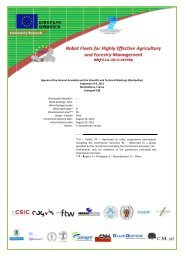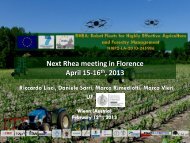1st Workshop BOOK - project RHEA
1st Workshop BOOK - project RHEA
1st Workshop BOOK - project RHEA
Create successful ePaper yourself
Turn your PDF publications into a flip-book with our unique Google optimized e-Paper software.
1. Optimal growth stage:<br />
2. Weed selectivity:<br />
3. Other data:<br />
Robotics and associated High technologies and Equipment for Agriculture<br />
Tribenuron<br />
Dicamba<br />
Fluroxipir<br />
Diclofop<br />
Fenaxaprop<br />
Clodinafop<br />
Tribenuron<br />
Dicamba<br />
Fluroxipir<br />
Diclofop<br />
Fenaxaprop<br />
Clodinafop<br />
Fig. 3. Example of a generic database of selected herbicides for winter wheat<br />
Finally, the `Agronomy´ database will provide information on field size, boundaries<br />
and obstacles, cropping history, drilling and harvest dates, expected yields,<br />
expected crop value, basic costs for operations such as soil tillage, fertilizing and<br />
spraying as well as values for the variable costs associated with each crop. Although<br />
default values are provided by the system in some cases, in other cases they should<br />
be filled by the user.<br />
4. Step 3: Current year decisions<br />
1 leaf 2 leaves 3 leaves Early Medium Late Jointing<br />
tillering tillering tillering<br />
Broadleaved weeds Grasses<br />
Galium Papaver Sinapis Veronica Avena Lolium Phalaris<br />
Excellent<br />
Commercial<br />
Dose /ha<br />
product<br />
Aceptable<br />
Cost<br />
(€ / ha)<br />
Toxicity Wildlife risk<br />
Poor<br />
None<br />
Resistance<br />
group<br />
Tribenuron GRANSTAR 15-25 gr 20 Xi B B<br />
Dicamba BANVEL 0.3-0.5 l 10 Xi B O<br />
Fluroxipir STARANE 0.75-1 l 25 Xi - O<br />
Diclofop COLT 2.5 l 25 Xn B A<br />
Fenaxaprop PUMA 1.0-1.25 l 38 Xn A A<br />
Clodinafop TOPIK 0.17-0.35 g 40 Xn A A<br />
Weed management in conventional wheat production relies heavily on herbicide<br />
use. Current year decision-making for herbicide use is a complex task requiring the<br />
integration of information on weed biology, expected crop yields and potential<br />
yield losses caused by different weeds, herbicide options, timing and efficacy of<br />
each herbicide, economic profitability of the treatment and environmental risks<br />
(Fig. 4). Agricultural growers and consultants can manage the integration of these<br />
complex factors by using decision support systems (DSS) (Parsons et al., 2009).<br />
7




